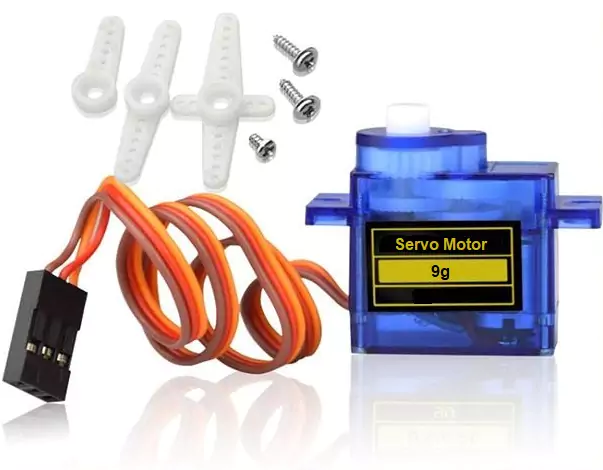What is the Servo Motor?
Servo motor is an electrical device that can be used to rotate the objects (like a robotic arm) precisely.
It’s a rotary actuator or the linear actuator which allows precise control of angular or linear position, velocity, and acceleration.
Servo implies an error sensing feedback control which is utilized to correct the performance of a system.
Related Article:- Interfacing Servo with Arduino.
It is actually an assembly of four things: a normal DC motor, a gear reduction unit, a position-sensing device, and a control circuit.
The DC motor is connected with gear mechanism which provides feedback to the position sensor which is mostly a potentiometer. From the gearbox, the output of the motor is delivered by servo spline to the servo arm.
For standard motors, the gears are normally made up of plastic whereas for high power servos the gears are made up of metal.
Servo motor has a rotation angle that varies from 0° to 180°.

Servo Motor Pinout
Commonly used servo motors typically have three main pins: power, ground, and signal. The power pin provides the necessary voltage to operate the motor, while the ground pin ensures a complete circuit for electricity flow. The signal pin receives control signals from an external device to determine the motor’s position.
| +VCC (Red) | Connect +VCC supply to this pin. For 9g Micro Servo it is 4.8 V (~5V). |
| Ground (Brown) | Connect Ground to this pin. |
| Control Signal (Orange) | Connect PWM of the 20ms (50 Hz) period to this pin. |
Components and Working Principle of Servo Motor
Servo motors are intricate devices comprising various components that work harmoniously to achieve precise control and motion. The key elements of a servo motor include a rotor, stator, feedback mechanism, and control circuit.
The working principle of a servo motor is based on closed-loop control systems where the feedback from an encoder or potentiometer continuously adjusts the position of the shaft to maintain accuracy. When the servo motor controller receives a command signal, it compares the desired position with the actual position and makes adjustments accordingly.
The rotor inside the servo motor spins when electrical current flows through coils in the stator, generating electromagnetic fields that interact to create motion. This controlled movement allows for accurate positioning within fractions of degrees.
Types of Servo Motors
Servo motors come in various types, each designed for specific applications. One common type is the AC servo motor, known for its high torque capabilities and precise control over speed and position. DC servo motors are another popular choice due to their simplicity and cost-effectiveness.
Brushless servo motors are uses for their efficiency and durability as they eliminate the need for brushes that wear out over time. On the other hand, brushed servo motors offer simplicity and ease of control but may require more maintenance. Linear servo motors provide linear motion instead of rotational output, making them ideal for applications like robotics and automation.
Specifications of Servo Motor
- Required Power: 4.8V – 6V DC max (5V works well)
- Average Speed: 60 degrees in 0.20 sec (@ 4.8V), 60 degrees in 0.16 sec (@ 6.0V)
- Weight: 62.41 gm
- Size mm: 40.7 x 19.7 x 42.9
- Spline Count: 25
Applications of Servo Motors in Various Industries
Servo motors find extensive applications across a wide range of industries due to their precision control and high efficiency.
- In the manufacturing sector, robotics commonly employs servo motors for tasks such as material handling, assembly, and welding.
- The automotive industry utilizes servo motors in automated systems for painting, welding, and conveyor belt operations.
- In the aerospace industry, servo motors play a crucial role in controlling flight surfaces such as flaps and rudders on aircraft.
- Servo motors are also prevalent in the healthcare sector for applications like medical imaging equipment and robotic surgery systems that require precise movements.
- Servo motors find wide application in automation, including packaging machinery, CNC machines, 3D printers, and various other fields.